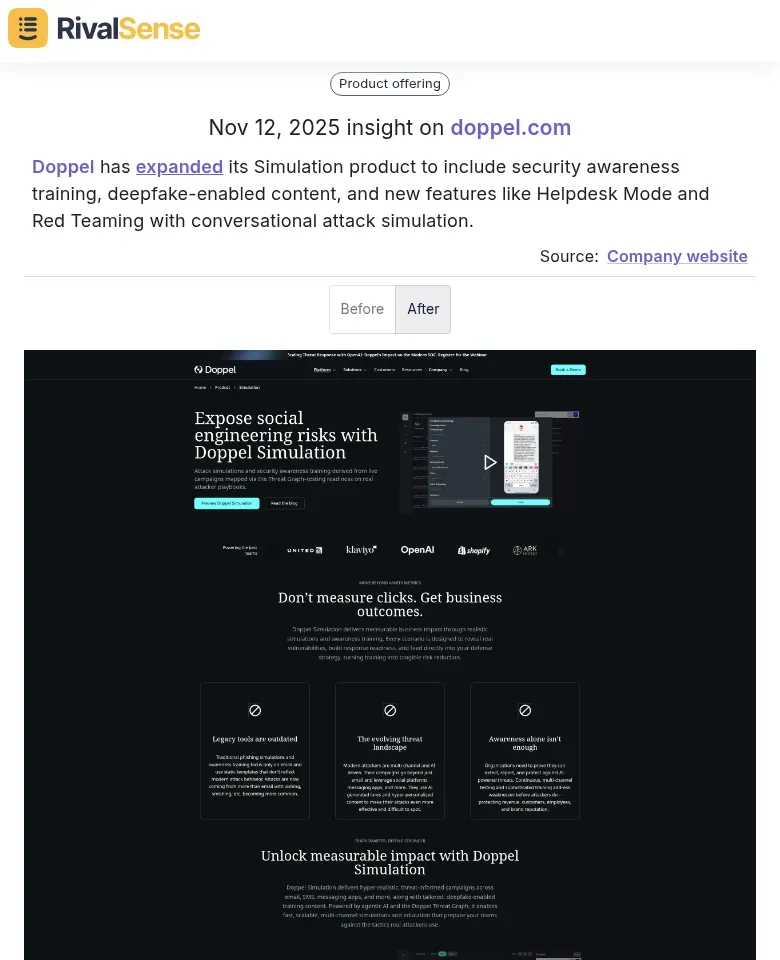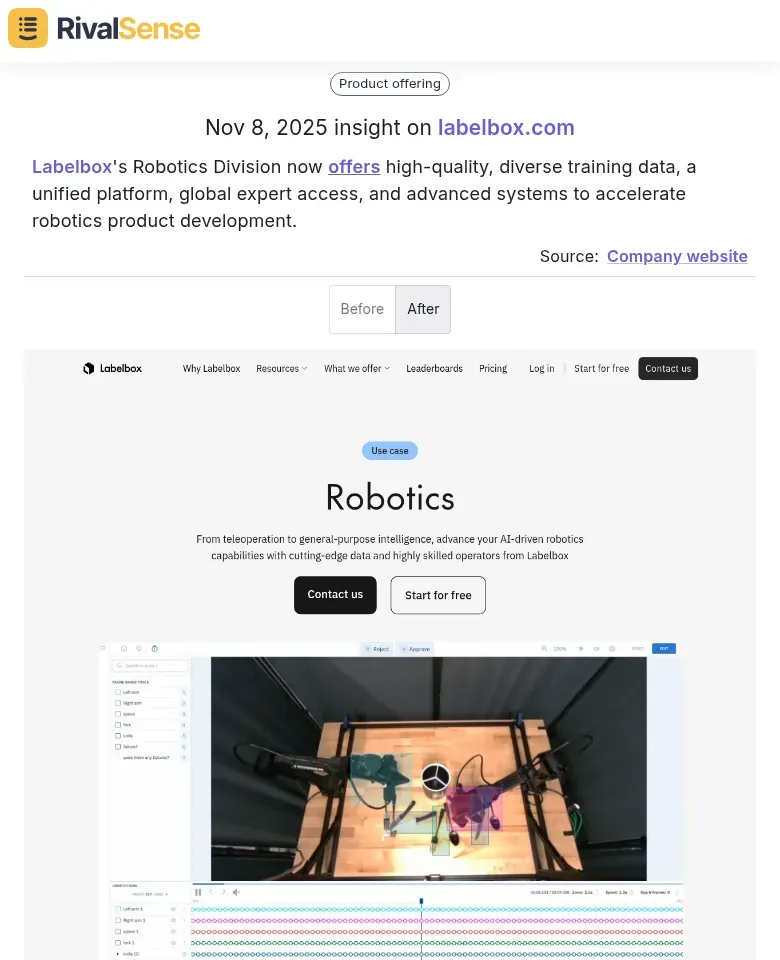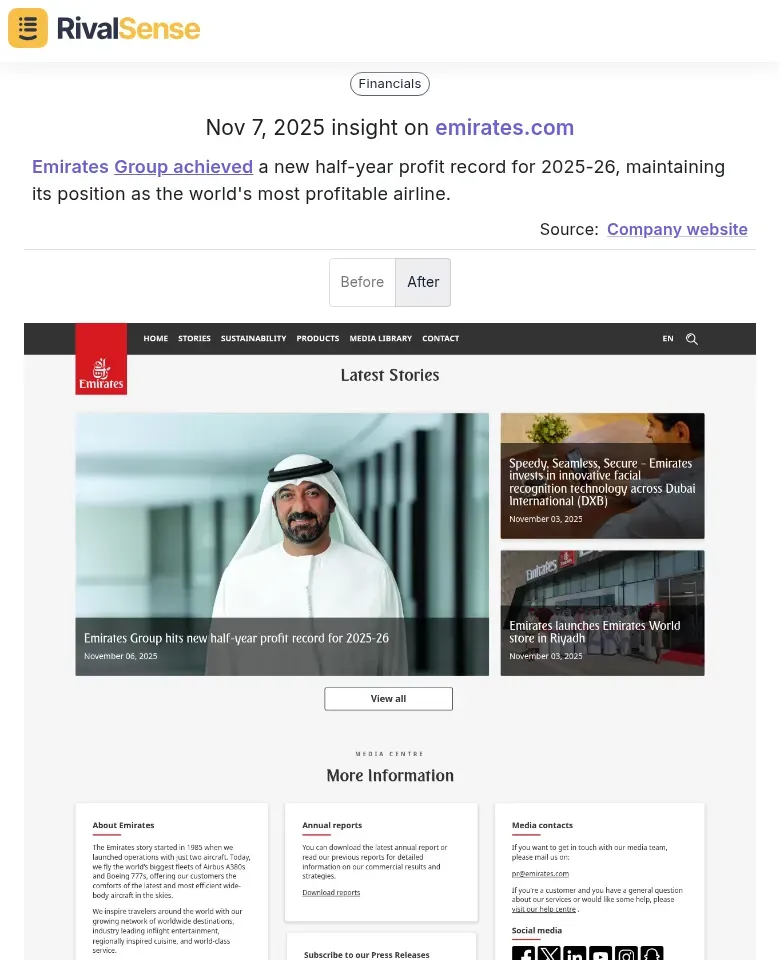Unlock Key Account Growth with Competitor Website Monitoring
In key account management, competitor website monitoring transforms passive observation into proactive intelligence that drives revenue growth. Strategic shifts often appear on competitor sites weeks before formal announcements—new product pages, leadership changes, or service updates signal critical market moves. For example, a competitor adding enterprise-tier pricing indicates a direct push for your high-value accounts, allowing you to anticipate and counter their strategies. These insights directly impact acquisition and retention: spotting a competitor's service gap lets you tailor pitches to win accounts, while monitoring their client testimonials helps you counter churn risks effectively.
To act decisively, create a simple checklist: track homepage updates, pricing pages, and career postings weekly; use tools like RivalSense for automated alerts on keyword changes; and analyze blog content for emerging strategic themes. This approach turns web watching into a sustainable competitive edge, ensuring you're not just reacting but anticipating shifts to safeguard and grow key accounts efficiently. 🎯
Product Expansion Insights: Identifying Market Gaps and Innovation Trends
Monitoring competitor product expansions reveals unmet customer needs and emerging innovation trends that can shape your strategy. When rivals introduce new features or diversify offerings, it signals where the market is heading and highlights potential gaps in your own portfolio. For instance, tracking these changes helps you benchmark your product roadmap and prioritize development efforts to stay ahead.
Consider how Doppel expanded its Simulation product to include security awareness training, deepfake-enabled content, and features like Helpdesk Mode—this type of insight is invaluable for identifying competitor innovation focus and validating your own product investments. By analyzing such expansions, you can spot underserved areas and accelerate your feature development to capture market share.

Practical steps to leverage product insights:
- Set up automated alerts for competitor feature launches and product updates.
- Create a quarterly comparison matrix of your features versus theirs to identify gaps.
- Prioritize high-impact innovations by testing new ideas with customer feedback before full-scale development.
- Use tools like RivalSense to track trends over isolated changes for real-time intelligence.
✅ Checklist for action:
- Monitor competitor blogs and release notes monthly.
- Identify where competitors are investing but you aren't.
- Align your roadmap with validated market demands.
Industry-Specific Enhancements: Capturing Niche Markets and Vertical Opportunities
Competitor moves into specialized verticals often reveal high-value niches that your business can exploit for growth. By tracking how rivals add industry-specific features or content, you uncover opportunities in underserved markets before they become saturated. This proactive approach allows you to launch tailored offerings that resonate with specific customer segments.
For example, Labelbox's Robotics Division now offers high-quality training data and a unified platform—this insight highlights how competitors target niche sectors like robotics, providing clues on vertical focus and potential partnership avenues. Understanding these enhancements helps you prioritize investments in high-growth areas and differentiate your solutions.

Practical steps to capitalize on vertical opportunities:
- Monitor competitor websites weekly for new features, industry-specific content, and client testimonials from niche sectors.
- Analyze gaps where competitors highlight certain industries but lack integrations—this is your chance to develop targeted solutions.
- Focus on verticals with sustained competitor investment, indicating long-term profitability.
✅ Checklist for action:
- Track blog content shifts and case studies for vertical signals.
- Identify and prioritize 2-3 high-value niches annually.
- Develop tailored messaging to address specific industry pain points.
Partnership and Expansion Signals: Anticipating Market Moves and Timing Counter-Strategies
Partnership announcements and expansion moves on competitor websites provide early warnings of market entry or diversification that could threaten your accounts. These signals help you anticipate competitor strategies and time your counter-moves effectively to protect and grow your key account base. By analyzing collaborations, geographic entries, or service additions, you can identify unmet needs and launch preemptive offerings.
For instance, a fintech firm partnering with a Southeast Asian bank signals regional entry, allowing you to ramp up localized solutions before competitors gain traction. Use these insights to assess expansion scope—whether geographic, product-based, or vertical—and prioritize gaps in your own capabilities for swift action.
Practical steps to leverage partnership insights:
- Monitor press releases, partnership pages, and executive statements weekly for new alliances.
- Set up alerts for competitor domain changes or new subsidiary registrations to catch early signals.
- Deploy counter-strategies within 3–6 months post-announcement to pre-empt market share loss.
✅ Checklist for action:
- Review competitor expansion announcements monthly.
- Assess the strategic impact on your key accounts.
- Plan and execute counter-campaigns targeting vulnerable client segments.
Financial Performance Insights: Gauging Competitor Health and Market Position
Tracking competitor financial achievements and operational milestones offers a window into their stability and growth trajectory, influencing your key account strategies. Insights like profit records or market position updates help you assess competitive threats and identify opportunities where rivals may be overextended or underperforming. This intelligence allows you to position your offerings as more reliable or innovative.
For example, Emirates Group achieving a new half-year profit record for 2025-26 reinforces its position as a market leader—this type of insight is crucial for understanding competitor strength and timing your moves to capitalize on any perceived weaknesses or shifts in client loyalty.

Practical steps to use financial insights:
- Monitor earnings reports, media mentions, and regulatory filings for performance indicators.
- Correlate financial health with product launches or service changes to predict future moves.
- Use this data in account reviews to reassure clients of your stability compared to competitors.
✅ Checklist for action:
- Track key financial metrics quarterly.
- Integrate insights into risk assessments for key accounts.
- Adjust pricing or value propositions based on competitor performance trends.
Actionable Intelligence: Turning Competitor Weaknesses into Key Account Wins
Transforming competitor website changes into actionable strategies enables you to convert vulnerabilities into tangible account gains. By identifying gaps such as product removals, pricing shifts, or service discontinuations, you can position your solution as a superior alternative and win over dissatisfied clients. This proactive approach ensures you're always ready to capitalize on competitor missteps.
For instance, if a rival drops a critical feature, use tools like RivalSense to detect this in real-time and launch targeted outreach campaigns. Time your efforts during competitor transition periods—like rebrands or migrations—when clients may feel uncertain, and emphasize your stability and tailored support to secure their business.
Practical steps to execute actionable intelligence:
- Track competitor announcements and set alerts for site changes to respond within 48 hours.
- Develop case studies that directly address competitor gaps, showcasing how you've solved similar challenges.
- Use A/B testing for messaging to refine your value propositions and leverage customer testimonials.
✅ Checklist for action:
- Schedule weekly reviews of competitor updates.
- Prepare templated responses for common competitor weaknesses.
- Train sales teams on leveraging intelligence in client conversations.
Implementation Framework: Building a Systematic Competitor Monitoring System
Establishing a structured competitor monitoring system ensures that insights are consistently captured and acted upon across your organization. This framework integrates automated tracking, centralized dashboards, and strategic workflows to turn data into decisive actions that protect and grow key accounts. By making competitor intelligence a core part of your operations, you foster a culture of proactive market engagement.
Start by setting up automated tracking tools that monitor competitor websites for real-time alerts on pricing changes, feature updates, content strategy shifts, and hiring patterns. These alerts should trigger immediately when competitors modify key landing pages or product descriptions, enabling swift responses. Then, create centralized dashboards that aggregate insights for sales, marketing, and product teams to collaborate effectively.
Practical steps for implementation:
- Use tools with customizable views, timeline tracking, and annotation capabilities for team discussions.
- Integrate insights into quarterly planning sessions to identify market gaps and refine strategies.
- In account management, leverage competitor changes to anticipate client concerns and address threats proactively.
✅ Checklist for action:
- Daily: Review automated alerts for critical changes.
- Weekly: Update dashboards and hold cross-functional briefings.
- Monthly: Conduct strategy sessions to align on competitive responses.
- Quarterly: Assess the competitive landscape and adjust plans accordingly.
Ready to transform competitor insights into key account victories? Try RivalSense for free and get your first competitor report today at https://rivalsense.co/—gain weekly updates on product launches, pricing changes, partnerships, and more to stay ahead in the market. 🚀
📚 Read more
👉 Boost Productivity with Competitive Car Rental Positioning Strategies
👉 Market Entry Trends: Competitor Regulatory Filing Insights 2025
👉 Decoding Competitor Moves: Schneider Electric's EV Charge Show Strategy
👉 How to Benchmark Against Competitors: A Practical Guide for B2B Leaders
👉 Avoid These Key Account Management Mistakes in Clinical Research
